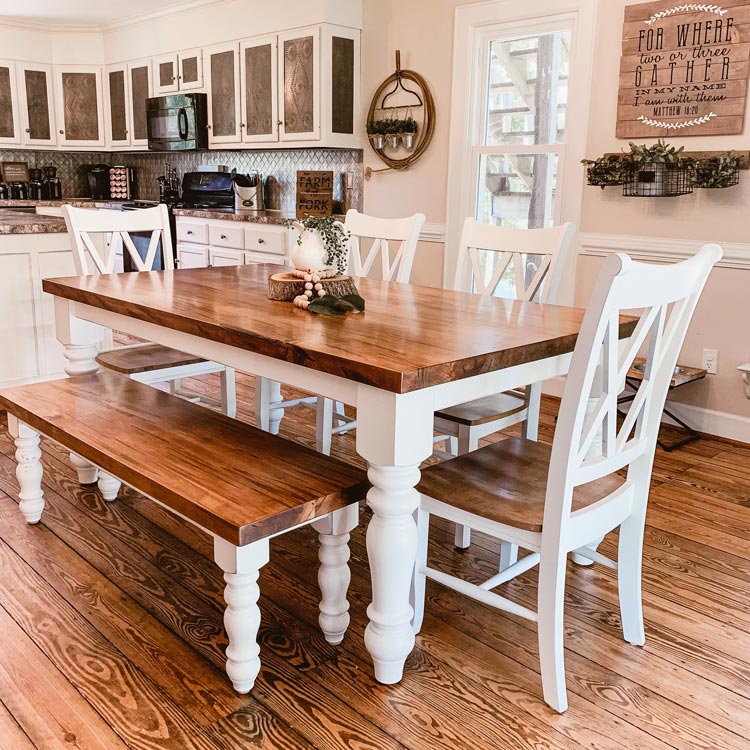Affordable and High-Quality Dining Room Table Legs for Every Budget
Wiki Article
From Conventional to Modern: Discover the Perfect Dining Room Table Legs for Your Design
While timeless layouts such as cabriole and turned legs stimulate a feeling of classic refinement, contemporary designs like barrette and geometric options provide a possibility for striking visual passion. As you think about these elements, the question stays: how can you flawlessly integrate these diverse leg designs to create an unified eating experience?Recognizing Table Leg Styles
The range of dining-room table leg designs can substantially affect both the appearances and functionality of the space. Each leg style adds unique visual components and sensible features, catering to diverse layout choices and usage demands. Comprehending these designs is essential for selecting the ideal dining table that straightens with your total interior decoration vision.For instance, tapered legs provide a clean, traditional look that can enhance an area's style, while pedestal bases supply stability and make best use of legroom, making them excellent for smaller spaces. Barrette legs, a trademark of mid-century contemporary design, introduce a commercial style, enabling an airy, open feel. Similarly, trestle legs evoke rustic appeal, supplying durable assistance and a sense of eternity.
Moreover, the selection of products plays a significant role. Wood legs can bring heat and structure, whereas metal choices commonly share a sleek, modern ambiance. Eventually, comprehending table leg styles is necessary for developing a natural dining area that mirrors personal style while ensuring practicality and comfort. By thoughtfully considering these aspects, you can improve both the useful and aesthetic charm of your eating room.
Traditional Table Leg Options
When selecting dining-room table legs, conventional alternatives typically embody ageless beauty and craftsmanship. These layouts show a rich heritage and a commitment to quality, making them perfect for those who value timeless looks.Among the most famous traditional leg designs is the cabriole leg, defined by its elegant curved shape. This style typically includes decorative makings and is most frequently found in Queen Anne and Chippendale furniture. One more prominent option is the transformed leg, which flaunts a collection of smooth, rounded forms that supply a classic appearance while maintaining stability.
Moreover, the straight leg, while easy, offers a unadorned and sturdy framework that can mix effortlessly with a variety of tabletop styles. For those drawn to ornate outlining, claw-and-ball feet legs evoke a sense of splendour and can function as a sensational prime focus in any dining area.
Lastly, pedestal bases, although not strictly legs, supply a different typical alternative that allows for ample legroom and can be wonderfully carved. Each of these standard leg styles adds to the total atmosphere of an eating room, marrying function with visual allure.

Modern Table Leg Designs
Modern table leg layouts use a diverse series of styles that highlight innovative materials and clean lines. These designs typically focus on capability while offering as striking centerpieces within a dining area. Minimal looks are widespread, with legs crafted from products such as steel, glass, and crafted wood, which add to a ventilated and modern feel.One preferred design is the barrette leg, defined by its slim, tapered framework that gives security without overwhelming the table top (dining room table legs). This style is usually located in mid-century modern-day furniture and can effortlessly match numerous table forms. An additional fad is the use of geometric shapes, where legs may take on asymmetrical or angular forms, adding aesthetic interest and a touch of virtuosity

Mixing Styles for One-of-a-kind Spaces
Usually, house owners look for to produce one-of-a-kind eating rooms that reflect their personal design by mixing different layout aspects. This method permits the unification of varied appearances, leading to a harmonious yet distinct environment. For example, matching a rustic wood table with streamlined, contemporary steel legs can produce an eye-catching contrast that boosts the area's total charm.Furthermore, incorporating vintage table legs with contemporary tabletops can stimulate a sense of background while preserving a contemporary perceptiveness. Such mixes not only showcase private taste yet additionally urge imagination, enabling house owners to curate a room that feels both personal and welcoming.
Color plays a critical role in this mixing procedure; choosing table legs that enhance or comparison with the existing article shade plan can boost aesthetic passion. Whitewashed legs can soften the boldness of a dark table surface, producing a well balanced visual.
Tips for Choosing the Right Legs
Picking the right table legs is essential for achieving both capability and aesthetic appeal in your eating area. Begin by taking into consideration the total style of your room. Typical settings take advantage of legs that include intricate carvings or turned layouts, while modern spaces might require sleek, minimal styles.Next, assess the height and security of the legs. dining room table legs. Basic eating tables range between 28 to 30 inches in height, so ensure the legs match this measurement for convenience. Furthermore, durable materials, such as hardwood or metal, can boost stability and long life
Examine the leg form also-- options consist of straight, tapered, or stand layouts. Straight legs use a timeless appearance, while conical legs can add a touch of beauty. Pedestal bases give ample legroom and are optimal for smaller sized areas.
Conclusion
In recap, picking the suitable dining room table legs needs careful factor to consider of both contemporary and traditional styles. By harmonizing leg design, height, and material with the general decor, he said a natural and inviting ambience can be accomplished.The range of eating area table leg styles can dramatically affect both the aesthetic appeals and functionality of the area. Ultimately, recognizing table leg styles is essential for developing a natural eating location that shows personal design while making certain usefulness and convenience.One of the most legendary conventional leg styles is the cabriole leg, identified by its graceful bent form. Straight legs offer a traditional look, while tapered legs can include a touch of elegance.In summary, picking the ideal dining room table legs requires cautious consideration of both traditional and modern-day styles.
Report this wiki page